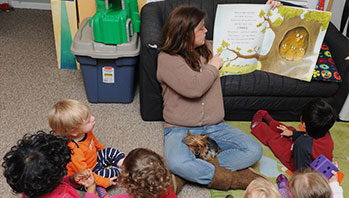- obstacle
- roll
MA Standards:
Literature: RL.PK.MA.1 With prompting and support, ask and answer questions about a story or a poem read aloud.
Literature: RL.PK.MA.4 With prompting and support, ask and answer questions about unfamiliar words in a story or poem read aloud.
Literature: RL.PK.MA.9 With prompting and support, make connections between a story or poem and one’s own experiences.
Literature: RL.PK.MA.7 With prompting and support, make predictions about what happens next in a picture book after examining and discussing the illustrations.
Language: L.PK.MA.4.a With guidance and support, generate words that are similar in meaning (e.g., happy/glad, angry/mad).
Head Start Outcomes:
Literacy Knowledge/Book Appreciation and Knowledge Asks and answers questions and makes comments about print materials.
Logic and Reasoning/Symbolic Representation Recognizes the difference between pretend or fantasy situations and reality.
Language Development/Expressive Language Uses increasingly complex and varied vocabulary.
PreK Learning Guidelines:
English Language Arts/Reading and Literature 6 Listen to a wide variety of age appropriate literature read aloud.
English Language Arts/Reading and Literature 10 Engage actively in read-aloud activities by asking questions, offering ideas, predicting or retelling important parts of a story or informational book.
Read Together: Ten on the Sled #1

© Commonwealth of Massachusetts, Department of Early Education and Care (Jennifer Waddell photographer). All rights reserved.
STEM Key Concepts: A ramp, or inclined plane, is a surface with one end higher than the other; Objects that slide are more likely to move on steeper inclines, and both rolling and sliding objects move faster down steeper inclines
ELA Focus Skills: Making Connections, Story Comprehension, Vocabulary
Tell children you are going to read the a counting book about animals on a sled. Set a reading focus for children by having the listen to what happens to each animal and to think about how the marbles rolled off their trackway when there were turns and obstacles.
Before You Read
Show children the cover of Ten on the Sled by Kim Norman. Have them locate the title and read it aloud with you. Ask children to point to the names of the author and illustrator. Read the names aloud, tracking them as you do.
Hold up the cover illustration. Ask children to describe what they see. Prompt them with questions if needed, such as,
- What is on the ground? (snow)
- What are the animals doing? (going sledding) Do you think they are having fun?
- What do you think will happen in the story?
As You Read
Read slowly and with expression so children can enjoy the rhythm of the words. Hold the book so everyone can see the pages as you read.
- Read the first page with children and count the animals with them.
- After the first few pages, ask children to predict which character will fall off the sled next.
- Pause to clarify meanings of words and terms such as chilled (cold) and wiped out (lost balance, fell). Ask children whether they can name any words that have similar meanings (synonyms).
After You Read
Talk about the story with children. Ask questions, such as,
- Did you like this story? What was your favorite part?
- How many animals started out on the sled ride at the top of the hill? How many were on the sled at the bottom of the hill?
- Point to the curvy tracks the sled makes and ask, What did you notice about how the seal slipped out of the sled that was similar to how Brianne’s marble slipped off her curved ramp?
- Why do you think the animals were falling out of the sled? (turning corners, going fast, hitting obstacles)
- Is this a real story or a make-believe story? How can you tell?
Adaptation: If younger children have trouble concentrating, read part of the book and return later to read more. Before continuing, discuss what has happened thus far to refresh memories.
English Language Learners: Before reading, use facial expressions, movements, and gestures to demonstrate the meaning of words. Then have children act out the words when you arrive at them in your reading.
